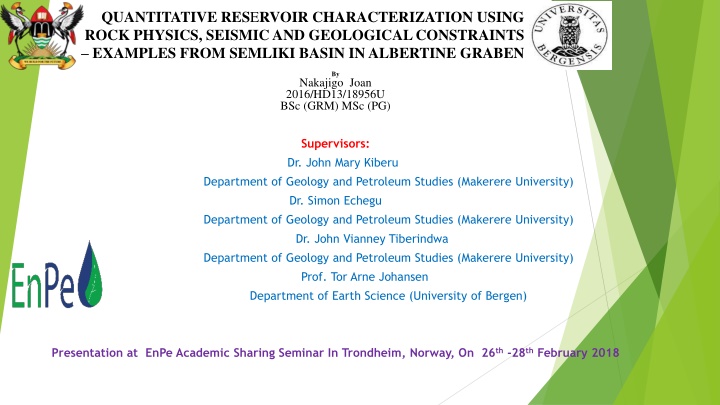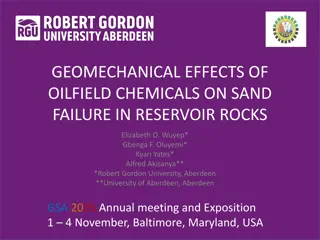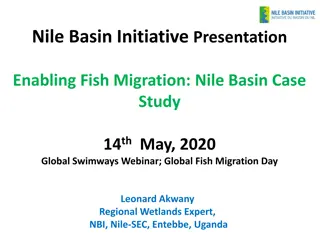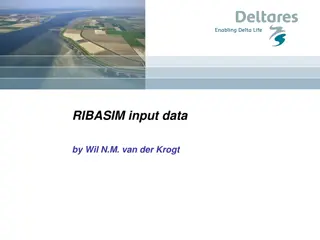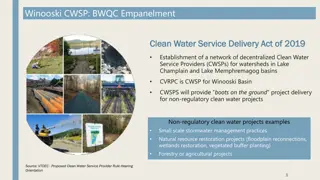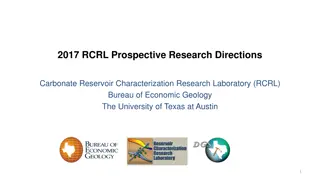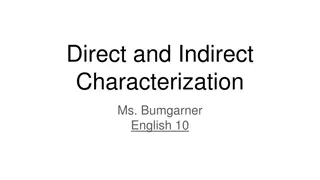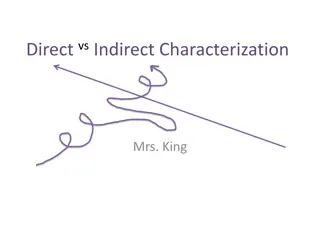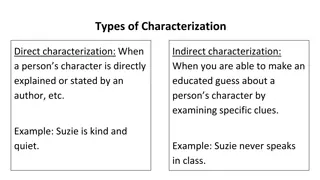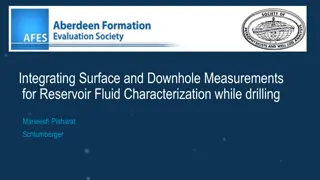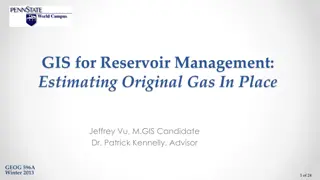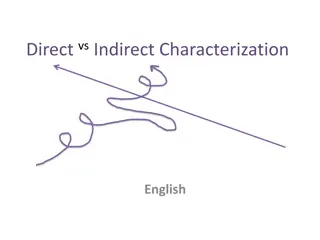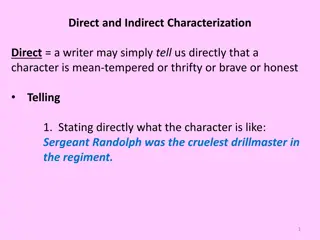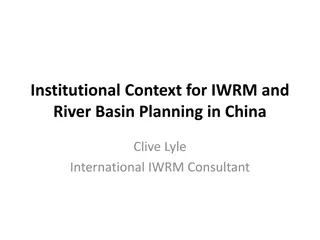Integrated Reservoir Characterization in Semliki Basin, Albertine Graben
Quantitative reservoir characterization using rock physics, seismic, and geological constraints is crucial for hydrocarbon prospect evaluation. This study by Nakajigo Joan explores the integration of these disciplines in the Semliki Basin to improve reservoir property delineation and reduce uncertainties. By combining rock physics models, geological constraints, and seismic data, the study aims to enhance reservoir prediction capabilities and minimize non-uniqueness in results. The presentation addresses the challenges, methodologies, and results of this integrated approach, highlighting the significance of coupling rock physics with geological constraints for more accurate reservoir analysis.
Download Presentation

Please find below an Image/Link to download the presentation.
The content on the website is provided AS IS for your information and personal use only. It may not be sold, licensed, or shared on other websites without obtaining consent from the author.If you encounter any issues during the download, it is possible that the publisher has removed the file from their server.
You are allowed to download the files provided on this website for personal or commercial use, subject to the condition that they are used lawfully. All files are the property of their respective owners.
The content on the website is provided AS IS for your information and personal use only. It may not be sold, licensed, or shared on other websites without obtaining consent from the author.
E N D
Presentation Transcript
QUANTITATIVE RESERVOIR CHARACTERIZATION USING ROCK PHYSICS, SEISMIC AND GEOLOGICAL CONSTRAINTS EXAMPLES FROM SEMLIKI BASIN IN ALBERTINE GRABEN By Nakajigo Joan 2016/HD13/18956U BSc (GRM) MSc (PG) Supervisors: Dr. John Mary Kiberu Department of Geology and Petroleum Studies (Makerere University) Dr. Simon Echegu Department of Geology and Petroleum Studies (Makerere University) Dr. John Vianney Tiberindwa Department of Geology and Petroleum Studies (Makerere University) Prof. Tor Arne Johansen Department of Earth Science (University of Bergen) Presentation at EnPe Academic Sharing Seminar In Trondheim, Norway, On 26th-28thFebruary 2018
Outline of the Presentation Background Objectives of the study Significance of the study Methodology Results Challenges 2
Introduction Seismic reservoir characterization is important in hydrocarbon prospect evaluation and production. There are a number of challenging problems causing uncertainties in the prediction results due to non- uniqueness and uncertainties in the input data. 3
Introduction To increase the prediction capability we need to reduce the non-uniqueness by inferring geological constraints as a part of the analysis. This study couples rock physics with geological constraints (burial history) and seismic to better delineate the reservoir properties of the reservoir unit in the Semliki basin with their uncertainties. 4
Introduction Rock physics provides a link between geologic reservoir parameters (porosity, clay content, sorting, lithology, saturation) and seismic properties such as acoustic impedance, P-wave/S- wave. velocity ratio VP /VS, bulk density, and elastic moduli. There are number of rock physics models Avseth, Mukerji, Mavko, and Dvorkin (2010); Avseth, Mukerji, & Mavko (2005) that are applied on particular rock type. 5
Introduction Odegaard & Avseth (2004) developed rock physics templates as a tool to evaluate lithology and pore fluid interpretation of well logs based on theoretical rock physics trends for different lithologies expected in the area. Inverse rock physics modelling (IRPM) was developed by Johansen, Jensen, Mavko & Dvorkin, (2013) to quantitatively analyze seismic data based on seismic inversion. 6
Semliki basin Albertine Graben , western arm of the rift valley. . exploration stage Currently, a number of fields are identified, drilling of appraisal wells is being done and approval of production license is ongoing
Problem Statement The fundamental challenge in the Semliki Basin, is lack of a clear understanding of the distribution of various reservoir properties such as porosity, lithology and fluid saturation. It was evaluated that there exist traps however, the reservoirs have poor lateral distribution (Heritage 2004, CNOOC, 2012).This research purposes to use various methods to quantify the prevailing uncertainties in this basin. Burial history combined with RPM, IRPM and quantification of uncertainties in relation to facies distribution using probability distribution function (pdf) will be done for the first time in this basin.
Objectives of the study Main Objective To quantify the prevailing uncertainties in the determination of reservoir properties of the Albertine Graben. Specific objectives To determine the effect of burial history on seismic properties or signatures. To establish the statistical relationship between reservoir properties. To examine uncertainties in different reservoir property distribution.
Significance of the Research This research will improve the overall understanding of the lateral internal structure of the study area and increase the predictability of several areas for well placement. The use of burial history technique will allow the overall record of important events that occur in the sedimentary basin. Rock physics modeling will aid in identification of appropriate model for the study area which can act as an input for future studies. IRPM will improve prediction of reservoir quality both well location and inter-well regions. This will add value to economy of Uganda by increasing new exploration prospecting areas and adding knowledge to this young industry. 10
Materials 3D seismic volume of Semliki basin 2D seismic of Semliki basin A suite of well logs and check shots data including their field reports of Turaco A suite of well logs and check shots data plus their field reports of Kanywataba. Softwares: ENTER, Hampson Russell, Petromod & PELE. 11
Use modelled parameters for burial history analysis Rock Physics modelling (RPM) Visualization using RPT (1) Reservoir properties (porosity, Lithology and fluid saturation Seismic data Well logs data Litho cube Porosity cube Fluid cube Monte Carlo simulation pdfs (3) IRPM (2) Bayesian classificatio n Seismic inversion Seismic inversion 12 Forward RPM
RESULTS The modelled parameters of Constant Cement model (bulk modulus, shear modulus, temperature, lithology among other) were used to determine; Compaction state or phase, Burial depth and Amount of uplift.
.Prediction of seismic velocities over time for constant cement model. The analyzed formation has started chemical compaction
. The analyzed formation indicate burial depth of 3500km and an uplift of 1596km
Challenges The data had issues in that, it would not tally with theoretical trends hence data quality control had to be done.
REFERENCE Avseth, P., Mukerji, T., Mavko, G., & Dvorkin, J. (2010). Rock-physics diagnostics of depositional texture, diagenetic alterations, and reservoir heterogeneity in high-porosity siliciclastic sediments and rocks A review of selected models and suggested work flows. Geophysics, 75(5), 75A31-75A47. Avseth, P., Mukerji, T., & Mavko, G. (2005). Quantitative Seismic interpretation: Cambridge University Press. Avseth, P., & Odegaard, E. (2004). Well log and seismic data analysis using rock physics templates. First break, 22(10), 37-43. HeritageOil&Gas. (2004). Final Well Geological Report for Turaco 2 Block 3, Albert Graben, Uganda. Department of Geology and Petroleum Studies, Makerere University. Johansen, T. A., Jensen, E. H, Mavko, G. & Jack Dvorkin, J. (2013). Inverse modeling for reservoir quality prediction. GEOPHYSICS, Vol. 78 Issue (2), M1-M18. doi: 10.1190/geo2012-0215. Yang, X., Yu, Y.,, & Dong, Y., Sun, Y.,. (2012). Final geological report of Kanywataba-l well in Kanywataba Exploration Area, Uganda. Department of Geology and Petroleum Studies, Makerere University
Acknowledgement I would like to thank the EnPe project for funding this research and the Nowergian government as a whole.
